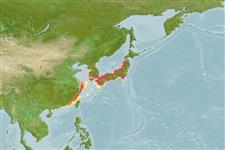Common names from other countries
Elasmobranchii (haaien en roggen) (sharks and rays) >
Carcharhiniformes (Ground sharks) >
Triakidae (Houndsharks) > Triakinae
Etymology: Triakis: tri-, from tres (L.), three; akis (Gr.), point, referring to each tooth consisting of one large central cusp flanked on by both sides by a small cusplet. (See ETYFish); scyllium: From skylion, Greek for dogfish or small shark. (See ETYFish).
More on authors: Müller & Henle.
Environment: milieu / climate zone / depth range / distribution range
Ecologie
marien; brak water demersaal. Subtropical; 48°N - 20°N
Northwest Pacific: southern Siberia to Taiwan (Ref. 244). Nominal records from the Philippines (Ref. 13563).
Lengte bij maturiteit / Grootte / Gewicht / Leeftijd
Maturity: Lm 103.5, range 99 - 108 cm
Max length : 150 cm TL mannelijk / geslacht onbekend; (Ref. 244)
Found on the continental and insular shelves, often occurring in shallow water close inshore. Prefers estuaries and shallow bays, especially sandy and algal-covered areas and eelgrass flats. Feeds on small fishes and probably crustaceans and other benthic invertebrates. Often solitary, though some may cluster in resting areas on bottom. Ovoviviparous (aplacental), with 10 to 20 young in a litter. Meat is regarded as of inferior quality.
Ovoviviparous, embryos feed solely on yolk (Ref. 50449).
Compagno, L.J.V., 1984. FAO Species Catalogue. Vol. 4. Sharks of the world. An annotated and illustrated catalogue of shark species known to date. Part 2 - Carcharhiniformes. FAO Fish. Synop. 125(4/2):251-655. Rome: FAO. (Ref. 244)
Status op de Rode Lijst van het IUCN (Ref. 130435)
CITES (Ref. 128078)
Not Evaluated
Gebruik door de mens
Visserij: van minder commercieel belang
Meer informatie
ReferentiesAquacultuurAquacultuurprofielKweeklijnenGeneticaElectrophoresesErfelijkheidZiektesVerwerkingMassaconversie
Tools
Speciale rapporten
Download XML
Internetbronnen
Estimates based on models
Preferred temperature (Ref.
115969): 14.8 - 21.8, mean 18.8 (based on 52 cells).
Fylogenetische diversiteitsindex (Ref.
82804): PD
50 = 0.5312 [Uniqueness, from 0.5 = low to 2.0 = high].
Bayesian length-weight: a=0.00240 (0.00110 - 0.00521), b=3.14 (2.96 - 3.32), in cm Total Length, based on LWR estimates for this (Sub)family-body shape (Ref.
93245).
Trofisch niveau (Ref.
69278): 3.8 ±0.2 se; based on diet studies.
Weerstandsvermogen (Ref.
120179): laag, minimale populatieverdubbelingstijd 4,5-14 jaar (Fec=10; K=0.16; tmax=20.6).
Fishing Vulnerability (Ref.
59153): High vulnerability (64 of 100).
